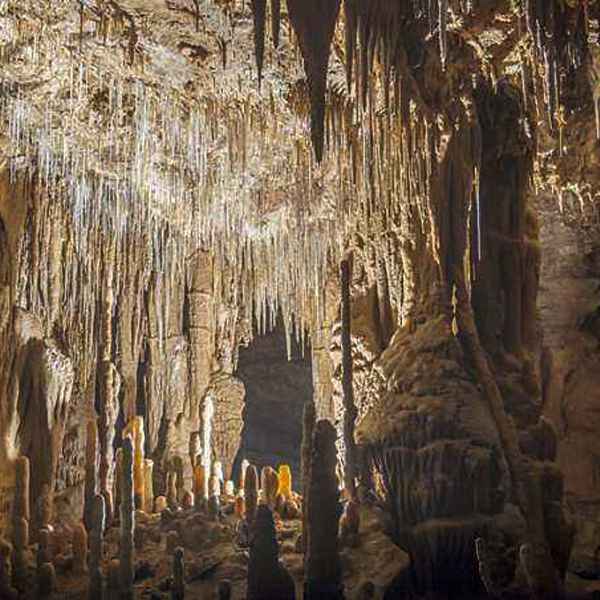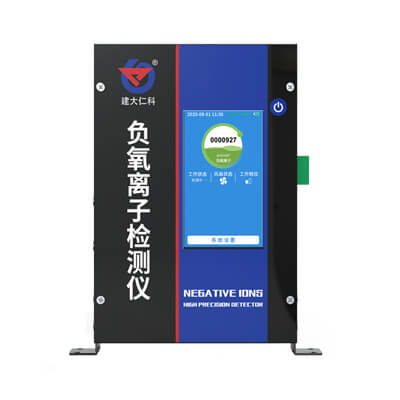What is a karst cave? The karst cave is a treasure given to mankind by nature and is called a “disposable non-renewable resource” by experts. It is the result of the long-term dissolution of groundwater in limestone areas under specific temperatures, humidity, and moisture conservation. The main component of limestone is calcium carbonate, which reacts with water and carbon dioxide to turn into calcium bicarbonate. Calcium bicarbonate is an inorganic acid salt that is easily soluble in water. In nature, underground water with carbon dioxide and rainwater with carbon dioxide have gradually formed karst caves due to the long-term erosion of limestone layers. To protect it from damage, a cave monitoring system can be installed.
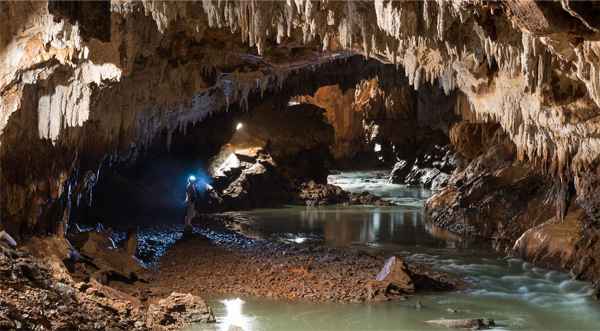
The problem of the karst cave environment
As the greenhouse effect deepens, the surface temperature gradually rises, causing the humidity in the cave to drop, which may cause dissolution.
As the karst cave attracts more and more tourists, more carbon dioxide and pollutants are brought into the cave. Excessive total carbon dioxide will continue to dissolve the rock on the cave surface and cause damage to cave resources. The concentration of negative oxygen ions has become an important parameter to measure the air quality in tourist resorts, and it has also become an important means of attracting tourists.
Therefore, it is necessary to find a balance point between the protection of karst caves and the use of karst cave resources, take a series of measures to protect the environment of karst caves, and make rational use of karst cave resources on this basis.
Karst cave monitoring system
In order to strengthen the protection of the cave environment, the Renke company launched the karst cave environment monitoring solution. The solution consists of a cave data acquisition system (meteorological solar radiation shield, gas solar radiation shield, negative oxygen ion detector, temperature sensor, water PH sensor, water conductivity sensor), signal transmission system (weather monitoring host, environmental monitoring host), environmental monitoring cloud platform, communication server and LED display.
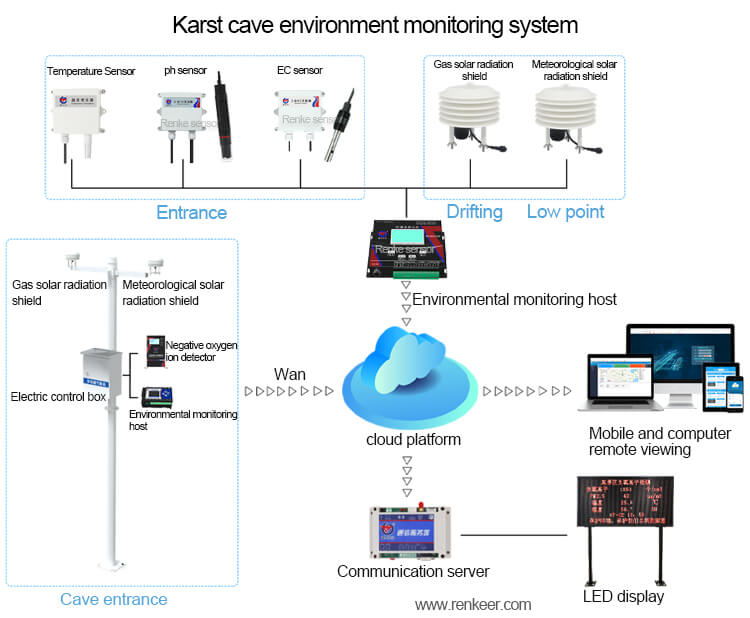
The purpose is to monitor the CO2 concentration, air temperature and humidity, water quality, and other environmental indicators in different locations of the cave in real-time, find abnormalities in time, help the staff to adjust the environment in time, and prevent the environmental change amplitude from exceeding the self-regulation range of the cave and causing the destruction of the cave landscape.
Components of karst cave monitoring system
The meteorological solar radiation shield can integrate carbon dioxide, temperature, and humidity sensor modules to monitor temperature, humidity and carbon dioxide indicators at the same time. The overall design is waterproof and dustproof, and it can work normally even in high humidity environments. The surrounding vents can effectively block insects and dust while ensuring air circulation. The equipment adopts standard MODBUS-RTU communication protocol, RS485 signal output, and the maximum communication distance can reach 2000 meters. It is widely used on various occasions that need to measure environmental temperature, humidity, and carbon dioxide.
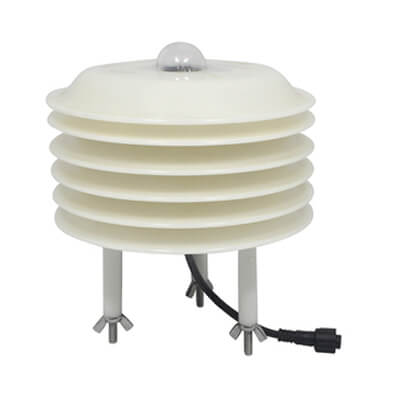
Power supply: 10-30VDC
Maximum power consumption: 0.8W.
Temperature humidity range: -40°C~+120°C, 0%RH~99%RH
T&H Accuracy: +0.5°C (25°C), 3%RH (60%RH, 25°C)
T&H Resolution: 0.1°C, 0.1%RH
Long-term stability: ≤0.1°C/y, ≤1%/y
Response time: ≤1s.
CO2 range: 0-5000ppm,
co2 Resolution 1ppm.
The gas in the cave is mainly N2, accounting for about 70%, followed by O2, and then carbon dioxide and methane. The principle of the formation of the karst cave is because the content of CaCO3 in the rock is high, and it reacts under the action of water and carbon dioxide: CaCO3+H2O+CO2=Ca(HCO3)2, and calcium bicarbonate is soluble in water, so the rocks are continuously dissolved, and over time, karst caves are slowly formed.
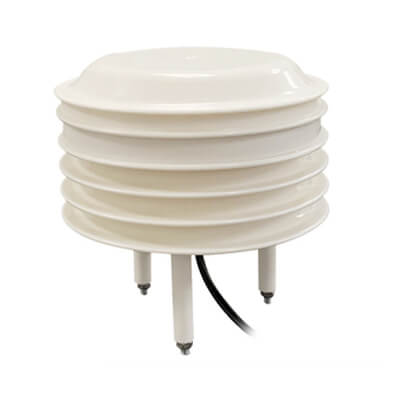
Power supply: 10-30VDC
Maximum power consumption: 1.2W
Oxygen range: 0~25%Vol
Resolution: 0.1%Vol
Accuracy: +3%FS
Warm-up time: ≥5 minutes
The gas unit adopts electrochemical and catalytic combustion sensors, which have excellent sensitivity and repeatability.
Using high-quality anti-ultraviolet materials, long service life, small size and lightweight.
The gas solar radiation shield is the gas detection part of the karst cave monitoring system. Similar to the appearance of the meteorological solar radiation shield, our gas solar radiation shield can integrate a variety of gases. Its size is larger than that of meteorological solar radiation, and its shell is harder and corrosion-resistant. When multiple gases are measured at the same time, they will not interfere with each other. A gas solar radiation shield can monitor a variety of gases in the karst cave.
The concentration of negative ions in the air is one of the signs of good air quality. Our negative oxygen ion detector has a liquid crystal display, which can display the concentration of negative oxygen ions in the air in real-time. It adopts a high-precision negative oxygen ion measurement unit and has good long-term stability. , The drift is small. The tester can directly press the key to set the parameters, which is easy to operate. The negative oxygen ion detector can monitor air negative oxygen ions in forestry, environmental protection, meteorology, tourism, etc., and improve air quality.
The formation of karst caves is inseparable from the erosion of flowing water. The most important thing for the monitoring of running water is temperature and water quality. RS-WD-N01-2-* is a sensor for measuring water temperature in the karst cave monitoring system. This temperature sensor adopts a wall-mounted high-grade housing with a protection grade of IP65, which can be used outdoors or in high-dust situations. With the use of high-sensitivity temperature sensing elements, the sensor has the characteristics of high measurement accuracy, strong anti-interference ability, etc., to ensure the excellent measurement performance of the product, and can dynamically monitor the water temperature in the cave for a long time. It is widely used in communication rooms, warehouse buildings, automatic control and other places that require temperature monitoring.
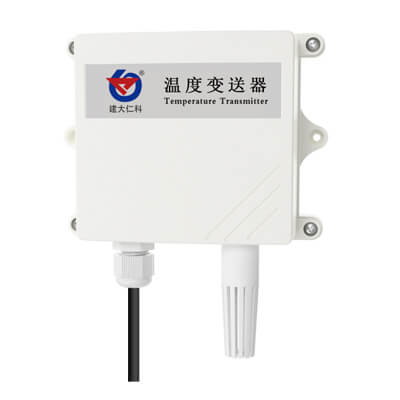
The equipment shell is waterproof and can be used outdoors
10~30V wide voltage range power supply
Maximum power consumption 0.8W
Temperature display resolution 0.1℃
Long-term stability of temperature ≤0.1℃/y
Can choose a relay output or buzzer alarm
Both the Ph sensor and the EC sensor are sensors for measuring water quality in the karst cave monitoring system. Water PH sensor is a device that measures the pH value (hydrogen ion concentration index, pH) of a solution. It adopts conventional composite electrode with high precision. The ph value of the flowing water in the cave can be monitored in real time. In addition, it can also be used for the measurement of solutions such as conventional sewage, tap water, environmentally friendly sewage, and domestic sewage.
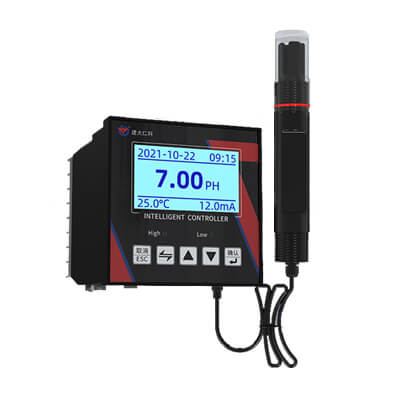
PH measurement range is 0~14pH, resolution is 0.01pH
10~30V wide voltage range power supply, power consumption 0.6W
The equipment has automatic temperature compensation function, manual compensation and automatic compensation can be switched at will
The enclosure protection grade is IP65, which can be used in outdoor rain and snow environment
The water conductivity sensor is a professional device for measuring the conductivity of the solution. It is used to monitor the conductivity of the flowing water in the cave. It is usually used with a pH sensor in karst cave monitoring systems. In addition, it can be widely used in continuous monitoring of the conductivity value of aqueous solutions such as section water quality, aquaculture, sewage treatment, environmental protection, pharmaceuticals, food and tap water.
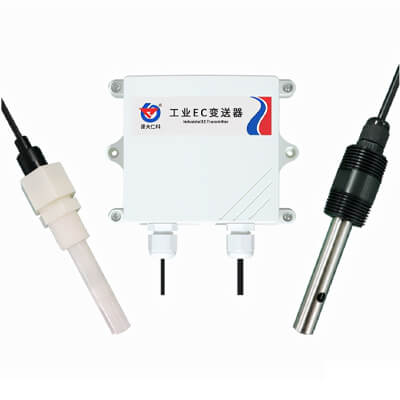
Conductivity measurement range K=1: 1~2000μs/cm, resolution: 0.1μs/cm. K=10: 10~20000μs/cm, resolution: 1μs/cm
Conductivity measurement error ±1%FS
Wide voltage power supply, 7~30V DC
With salinity and TDS conversion function
7. Communication server (RS-DCEN-M-*)
The communication server is a relay server developed and produced by our company for remote monitoring equipment and transmitting data through the network port. The equipment can transmit the data to the LED screen and display it in real time. It can receive data from 32 nodes at most and transmit data to 8 LED screens at the same time. Meet the wireless real-time monitoring requirements of multiple scattered, long-distance, and unattended industrial monitoring points at the same time.
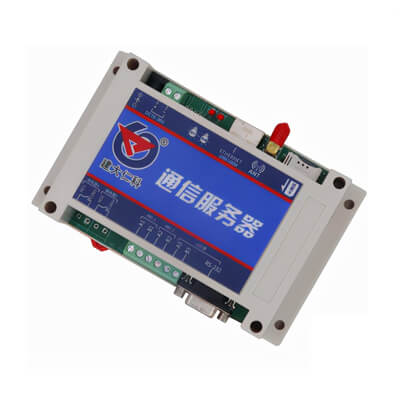
The RS232 and RS485 two communication protocols can be connected to the LED screen.
The data will be refreshed automatically after power failure.
Maximum support for 512*1024 pixel LED screen.
Support text, clock, table display;
DC10~30V wide DC power supply voltage.
Our outdoor LED screen is a fixed device that obtains data from the cloud platform and displays the data on the large LED screen.
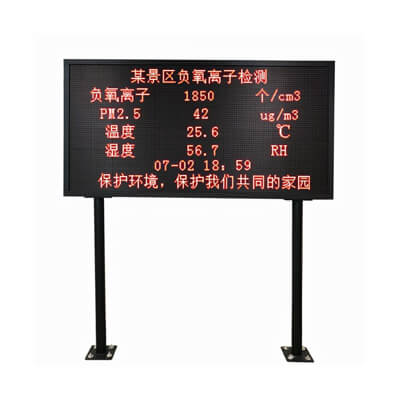
The large screen can play the real-time data of 32 nodes on a round screen, divided into 4 screens, the large screen adopts a 192*96 array, the pole height is 1.5m, the screen width is 2m, and the height is 1.04m. The font size can be set, and real-time data can be viewed directly from a distance.
9. Weather monitoring host (RS-QXZ-M-Y)
The weather monitoring host is the weather data collection terminal of the karst cave monitoring system, which can collect data from all weather sensors. It has 1 ModBus-RTU master station interface (can be connected to other types of our company’s 485 sensors through this interface), 4 analog signal acquisition, 1 immersion detection, 4 switch acquisition, and 2 relay output. With 1 ModBus-RTU slave interface, data can be uploaded to the customer’s monitoring software or PLC configuration screen through 485 communication. The host supports SMS alarm function, and remote parameter configuration can be carried out through SMS.
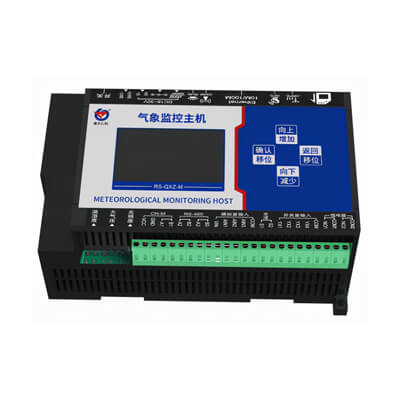
Can be connected to all types of 485 sensors. For example: sensors for wind speed, wind direction, soil moisture, etc.
Built-in data storage, can store 520,000 records, when communication fails, the device automatically stores. The stored data can be uploaded after the communication is restored
Can be connected to an outdoor LED monochrome display, support the maximum number of dots 1024*25
10. Environmental monitoring host (RS-XZJ-100-Y)
The environmental monitoring host is another data acquisition device of the karst cave monitoring system. Through the RS485 interface, all RS485 transmitters such as temperature sensors, water PH sensors, and water EC sensors can be connected to the environmental monitoring host , It uploads the data monitored by each sensor to the environmental monitoring cloud platform in real time.
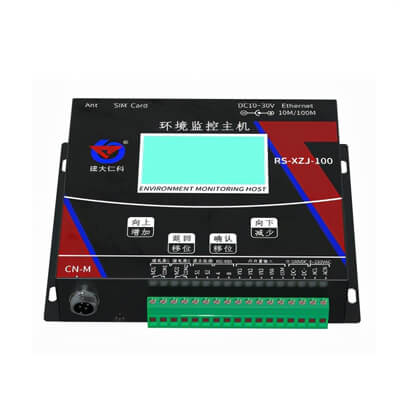
Support 4G, Ethernet, RS485 wired and other methods to upload data
Offline SMS alarm function, the content of the alarm can be customized (optional function)
Built-in data storage, can store 520,000 records
Can automatically identify whether the RS485 interface slave device is working properly
The environmental monitoring cloud platform is a way for the cave monitoring system to view data through the web. , You can log in at different terminals through your account and password. Actively receive all monitoring data uploaded by the monitoring host and display it in real time on the platform interface.
Real-time monitoring information, historical data curve viewing, and alarm information can be pushed to managers through information terminals such as mobile phones, Pads, and computers, so that staff can take timely measures to improve the stability and reliability of their monitoring.
12. Yun kong tong APP
In order to facilitate mobile terminal users to view the data of the cave monitoring system, our company has launched the “Yun kong tong” mobile phone APP, which is convenient for users to monitor in real time 24 hours a day. You can log in to the cloud platform account to view the status of the device in the account through the account password, and you can control tens of thousands of devices with one key. It supports video viewing, equipment failure abnormal alarm, offline alarm function, real-time data viewing, historical data curve viewing, and it can also connect to a Bluetooth printer for data printing, which is powerful.
The functions that can be realized by the karst cave monitoring system
1. Real-time monitoring
The karst cave monitoring system can monitor the data of each monitoring point in real time.
2. Over-limit alarm
When any value exceeds the limit, the platform will immediately remind the management personnel by interface alarm, telephone alarm, SMS alarm, email alarm, etc., and record the event for call and analysis.
3. Electronic map
The map displays the device location, online status and data information in real time.
4. Historical data query
The historical data of one or more monitoring points can be queried, and the corresponding monitoring points, time range and data type can be selected for query according to the needs.
5. Mobile supervision
Support mobile client to view data in real time, realize remote monitoring by supervisors and view data anytime and anywhere.
6. Account hierarchical management
Support account hierarchical management, multiple sub-accounts can be assigned to the main account, with different account levels and different permissions.
Related blogs
Temperature and humidity monitoring are the two most important elements of indoor environmental monitoring. A suitable temperature and humidity environment can not only make your
Natural disasters such as floods and heavy rains pose threats to lives and property around the world. Without a proper flood monitoring system, these natural
In the current society, noise pollution has become the third-largest source of pollution after air and water pollution. To ensure normal rest and sleep, the
A greenhouse is a closed environment that provides optimal conditions for plant growth and promotes plant growth by controlling indoor and outdoor environments. A complete
Table of Contents Modern companies are placing an increasing emphasis on the value of collected data. As a result, central data centers, IDCs, and similar
Agricultural irrigation mainly refers to irrigation operations carried out in agricultural farming areas. Agricultural irrigation methods can generally be divided into traditional surface irrigation, ordinary
IoT is based on sensors and is an extension of the Internet. It connects all items with the network through sensors, achieving the purpose of

